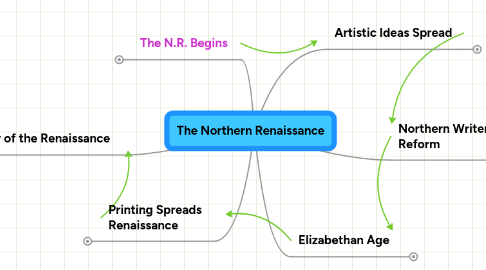
1. The N.R. Begins
1.1. Northern Europe begins to grow again by 1450
1.1.1. When the Hundred Years' War broke out, cities grew rapidly, which lead to more patrons of the arts
1.1.1.1. While Italy were city-states, England and France were strong monarchies. The kings were solid patrons of the arts.
2. Printing Spreads Renaissance
2.1. Europeans decide to use a printing machine to print things on paper.
2.1.1. In 1440 Johann Gutenberg developed the printing press, which sped the copying of books dramatically.
2.1.1.1. The first Bible printed on movable type was printed in 1455. Books soon became cheap enough that many people could buy them.
3. Legacy of the Renaissance
3.1. The European Renaissance affected the world tremendously.
3.1.1. Changes in Art: Paintings and sculptures were more life-like; Art became secular and religious.
3.1.1.1. Changes In Society: Larger demand for books inspired a hunger for learning; Laws became clearer and easier to understand with the rise in literacy; people began to question political structures and religious practices.
4. Artistic Ideas Spread
4.1. In 1494, the French invaded Italy. Many Italian writers and artists fled to Northern Europe.
4.1.1. The refugees brought with them the techniques and styles of Italy, spreading Italian Renaissance ideas.
5. Northern Writers Try Reform
5.1. Humanists realized the failure of the church to inspire people to live Christian lives.
5.1.1. Christian Humanists tried to reform society and promoted co-education.
5.1.1.1. Thomas More was a large influential figure in the Christian Humanism Movement. He wrote the book "Utopia", which gave a better model of society.
6. Elizabethan Age
6.1. In the mid-1500s the Renaissance came to England, named the Elizabethan Age for their Queen Elizabeth the first.
6.1.1. William Shakespeare lived during this age, writing arguably the most influential plays and poems of all time.
